THE THEATRE ORGAN
PART TWO: BUILDERS OF THE THEATRE ORGANS
THE WURLITZER THEATRE ORGAN CONTINUED
-oOo-
PAGE TWO: BUILDING THE WURLITZER ORGAN
IN THE U.K.
-oOo-
THIS PAGE IS WRITTEN IN CONJUNCTION WITH GLEN TWAMLEY
(FRIENDS OF BEER WURLITZER)
-oOo-
This Video was produced by Mr. Paul Bland especially for this website and gives
an amazingly full account of The Four Phases of the Wurlitzer Organ in a short space of time.
I am extremely grateful to Mr. Bland for his time, effort and kindness in producing this excellent Video.
-oOo-
Almost all Theatre Organs were installed in the U.S. prior to the advent of talking pictures and fell-out-of-fashion thereafter. The situation in the U.K. did not reflect this trend and most of the Wurlitzer Theatre Organs came to the U.K. later, with many instruments having been installed previously in American Picture Palaces.
The Theatre Organ in the U.K. helped augment the cinema experience once the talkies arrived and were played during musical interludes, as part of the offered entertainment. This situation continued until the outbreak of the Second World War.
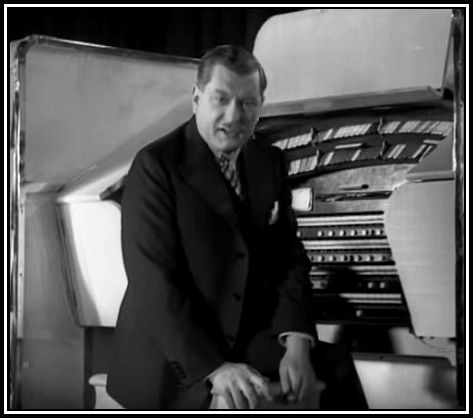 Reginald Foort
Reginald Foort
It has been suggested that it was the broadcasts of the organist Reginald Foort (1893-1980) at the New Gallery Cinema that re-sparked an interest and the nationwide love affair with the Theatre Organ. The organist and former Custodian of the Trocadero Wurlitzer Theatre Organ for a number of years when it was installed at Edric Hall, South Bank University, Mr. David Lowe, tells me that Mr. Foort’s first broadcast was accidental! Seemingly an orchestra had been given a broadcast slot and when it had finished playing, apparently, the BBC had nothing to follow and a silence was expected to ensue! However, Mr. Foort started to play and the technicians wisely kept the microphones live, and as they say, A Star was Born! And the Theatre Organ figuratively speaking ……. stepped into the spotlight and into history!
-oOo-
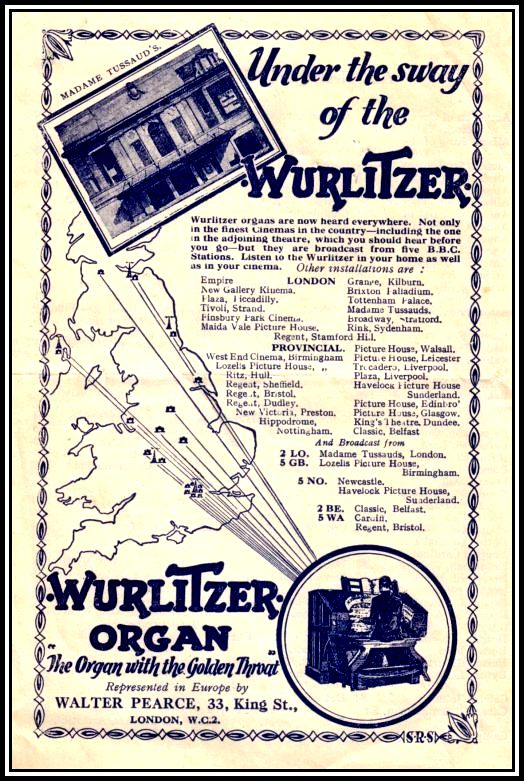 Water Pearce in London, the representative of Wurlitzer Organs in Europe
Water Pearce in London, the representative of Wurlitzer Organs in Europe
-oOo-
The European representative for The Wurlitzer Organ Company was Walter Pearce at 33 King Street, London W.C.2., who was in partnership with Major S.J. Wright. Mr. Pearce had worked at one time for Aeolian in the U.S. and had a reputation for being a competent organ builder.
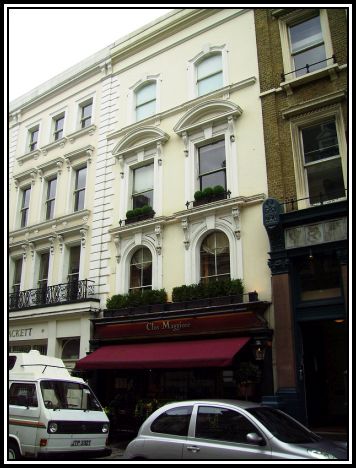 33 King Street, London W.C.2. is now a restaurant
33 King Street, London W.C.2. is now a restaurant
Since The Wurlitzer Organ Company was not as well known in the U.K. as it was in the U.S., the company required the skills of a representative here who both knew the market and was willing to spend the time to forge a niche. Wurlitzer Organs were costly since they were more expensive than those made in the U.K. In addition, their organs were subject to import tax and additional shipping costs, which added to their price. Despite these seeming disadvantages, the skills of Mr. Pearce were such that he was able to carve out a market for the Wurlitzer Organs with twelve organs being sold to cinema owners in the U.K. between 1924 and the end of 1926.
In order to reduce the price of the Wurlitzer Organ, Mr. Pearce introduced several ways to cut production costs. The first of these was made by purchasing English-made Discus Blowers with the majority being made by Watkins & Watson Limited of Islington, London, which allowed in a marked reduction of the shipping costs.
A second method employed by Mr. Pearce to reduce the price of an organ, was to offer a slightly smaller version of a model. An example of this may be seen in the case of the popular Style-D instrument from which the Style-DA organ was developed. This variant was achieved by removing the 16-foot Diaphone, which consisted of twelve heavy metal pipes resulting in a 20% reduction in price and, according to their advertisement, without loss of quality.
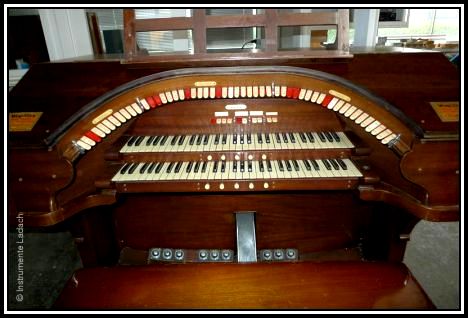 The Console of the Style-D Organ
The Console of the Style-D Organ
In 1933, as a way to avoid import tax completely and reduce the price of the organ further, a factory was opened in Charlton Kings Road in Kentish Town, London N.W.5 where parts of the organ were to be built.
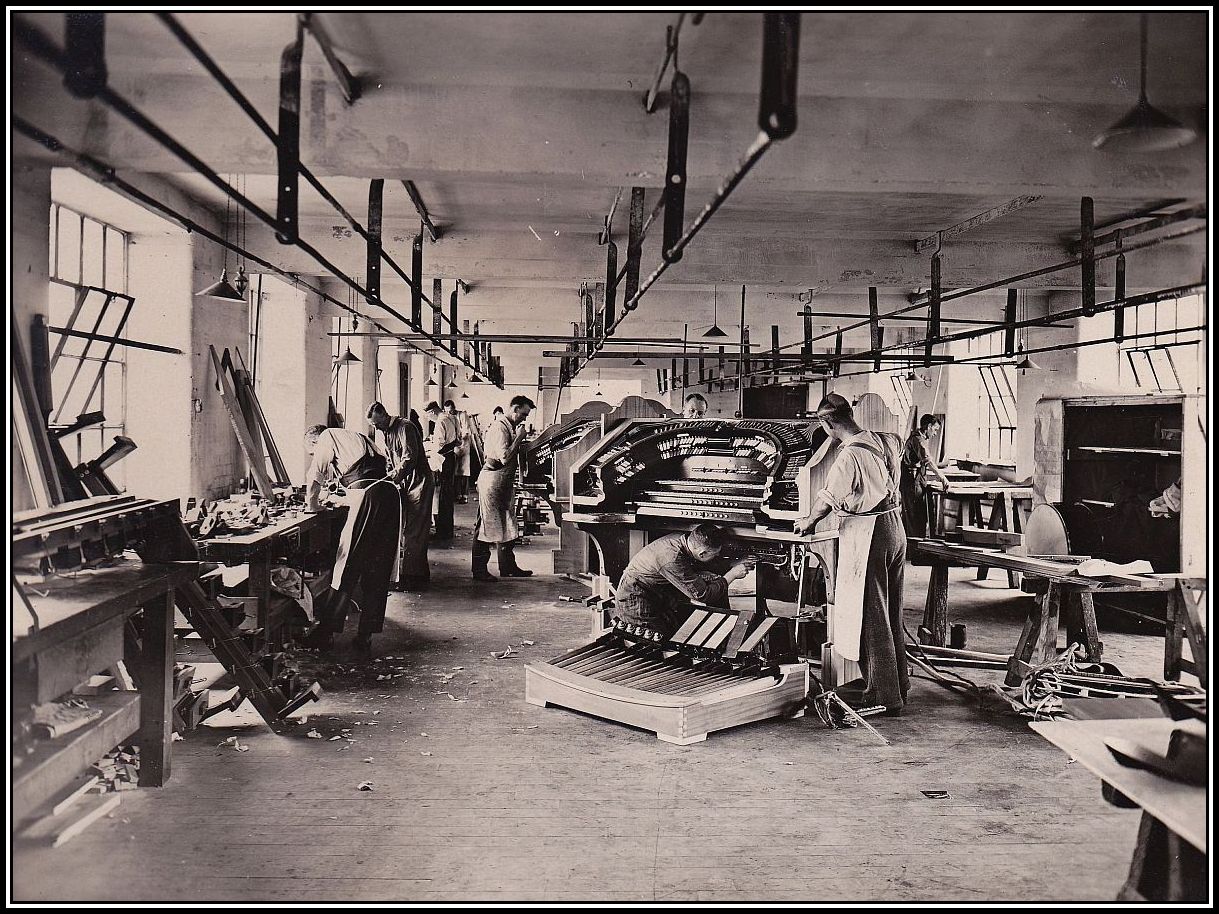 The Wurlitzer Factory in Kentish Town – the Organ in the foreground was destined for installation at the Regal Cinema Edmonton and the one behind for the Troxy Cinema Stepney
The Wurlitzer Factory in Kentish Town – the Organ in the foreground was destined for installation at the Regal Cinema Edmonton and the one behind for the Troxy Cinema Stepney
The vital parts of the organ that required special skills continued to be made at the Tonawanda factory in the U.S., but various items such as swell shades, console cases and reservoirs were able to be built in the Kentish Town factory.
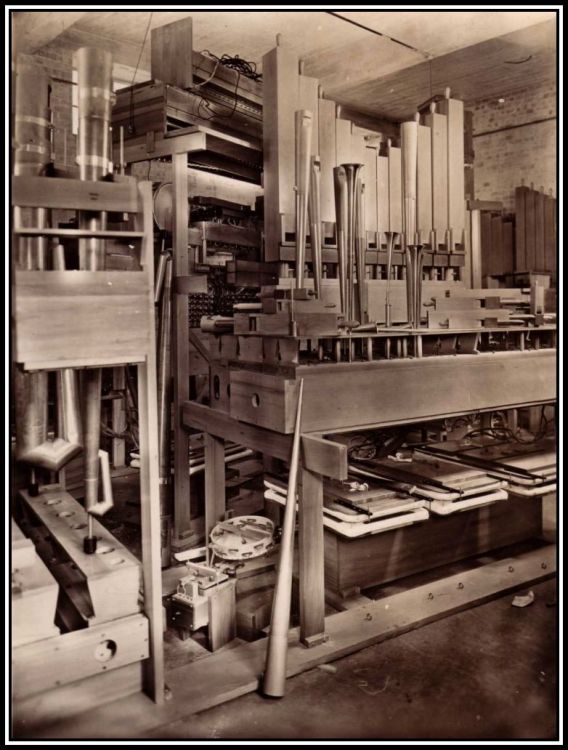 The Wurlitzer Factory in Kentish Town
The Wurlitzer Factory in Kentish Town
As a result of Mr. Pearce’s efforts, Wurlitzer Organs were greatly reduced in price, thereby allowing them to become more competitive with British-built theatre organs.
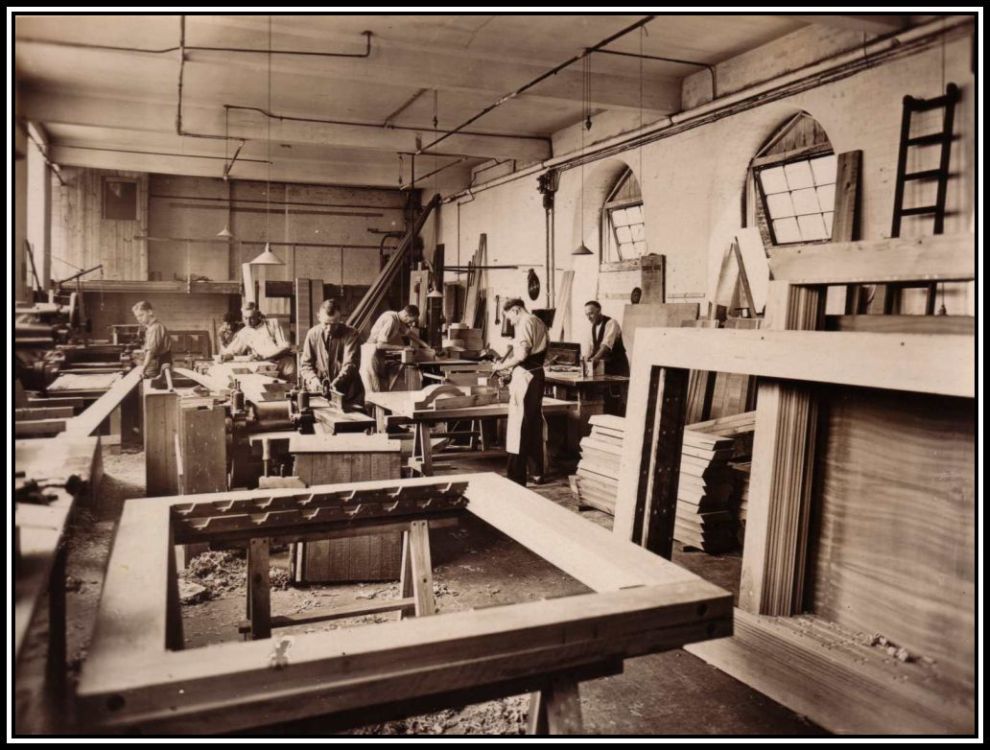 The Wurlitzer Factory in Kentish Town
The Wurlitzer Factory in Kentish Town
Although most of the organs made in the U.K. were sold there, some were also sold to Germany, France, The Netherlands, Sweden, Denmark and South Africa. Those organs that were installed in and around London were tuned and maintained by Major S.J. Wright, the partner of Mr. Pearce.
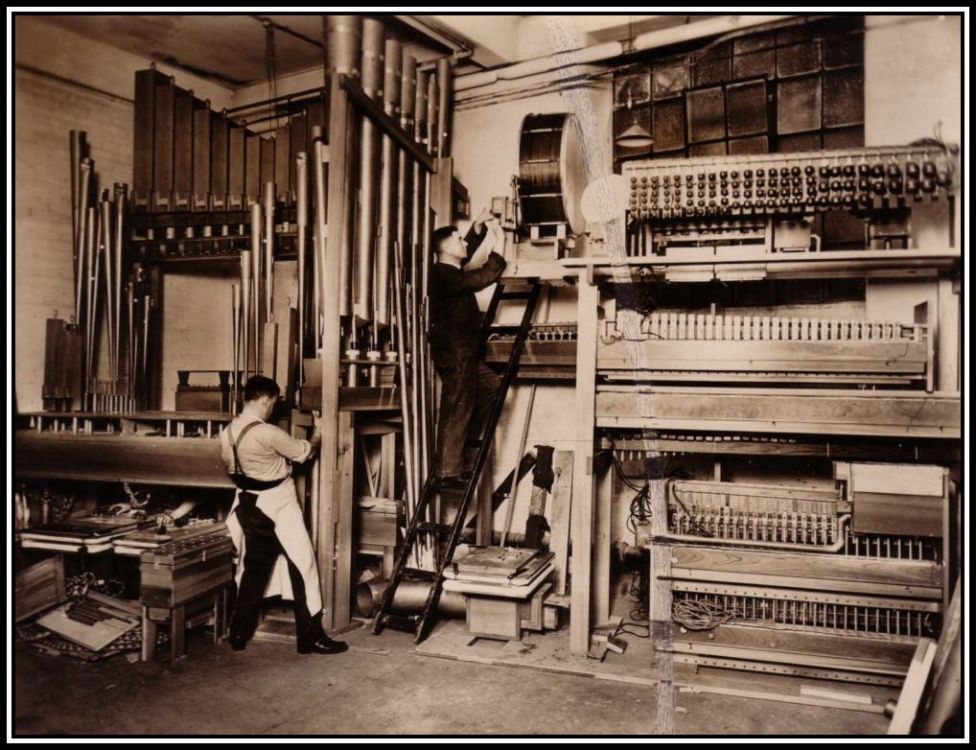 The Wurlitzer Factory in Kentish Town
The Wurlitzer Factory in Kentish Town
-oOo-
The Wurlitzer Organ Company offered a range of basic models. The owners of the cinema chains were able to make a choice from these and find one that would suit their needs. Once the choice was made, all that was left was to arrange its installation in their cinemas.
In spite of offering a range of organs to choose from, many of the instruments manufactured were actually “Specials”. Some of these “Specials” were derivatives of the standard models where changes had been made to an original specification while other special organs were to the design or following specific requests of some of the organists of the day, thereby making them one-offs.
-oOo-
From the price list of 1926, as drawn up by Walter Pearce at 33 King Street, London, W.C.2, the standard range of Wurlitzer Organ on offered in the U.K. may be seen. The organs for sale were either two or three manuals.
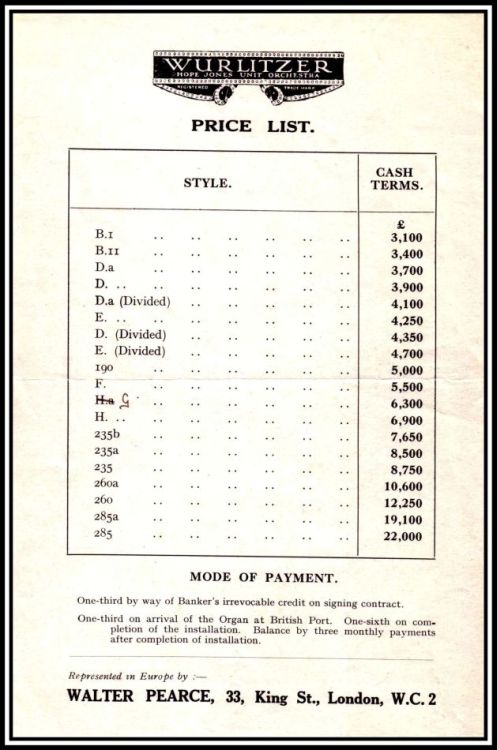 The Price List published in 1926
The Price List published in 1926
-oOo-
The two manual Wurlitzer Organs sold in the U.K. were:
Style-B, Style-D and its variants, Style-E, Style-F and Style-H.
The Style-B Wurlitzer Organ was the simplest and least costly of the products and consisted of two manuals and four ranks with three tonal percussion instruments. In its standard format, only one was sold in the U.K., which was installed at the Palladium Cinema at Brixton.
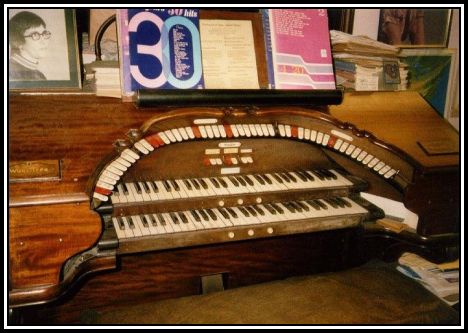 Console of a Style-B Wurlitzer Organ
Console of a Style-B Wurlitzer Organ
This photograph appears at the website of the Puget Sound Theatre Organ Society (PSTOS) and appears here with permission of Mr. Tom Blackwell. The history of this console may be found at this website.
-oOo-
In addition, two Style-B “Specials” were also sold. These specials were instruments where an additional rank of pipes had been added to the standard Style-B 4-rank organ. There is only one Style-B “Special” still in use today in the U.K. and this was the Filmaphone (Decca) Wurlitzer, which is now in a private home. The other Style-B “Special” was installed at Lozells Birmingham was was destroyed in an air raid in 1942.
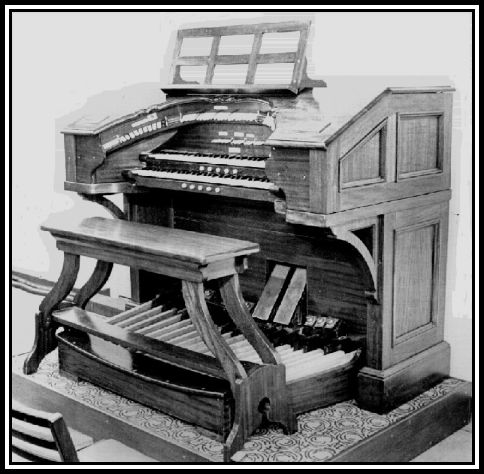 Console of a Style-B “Special” Wurlitzer Organ
Console of a Style-B “Special” Wurlitzer Organ
-oOo-
The Style-D Wurlitzer Organ was a more complex instrument. In the U.S., this was The Wurlitzer Organ Company’s top-selling stock model, however, in the U.K., only five such instruments were sold. Although the Style-D Wurlitzer Organ was also a two manual instrument, it had six ranks of pipes with four tonal percussion instruments and some additional non-tonal percussion instruments lacking in the Style-B Organ.
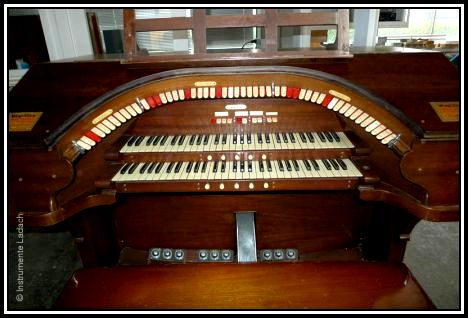 Console of a Style-D Wurlitzer Organ
Console of a Style-D Wurlitzer Organ
-oOo-
From the price list, it may be seen that Walter Pearce offered several derivatives of this model i.e. Da, D, Da (divided) & D (divided). The standard Style-D Organ was designed to be installed in one chamber while those listed as “divided” were designed to be installed in two chambers. Both the Beer and the Rye Wurlitzer Organs are examples of Style-D Organs.
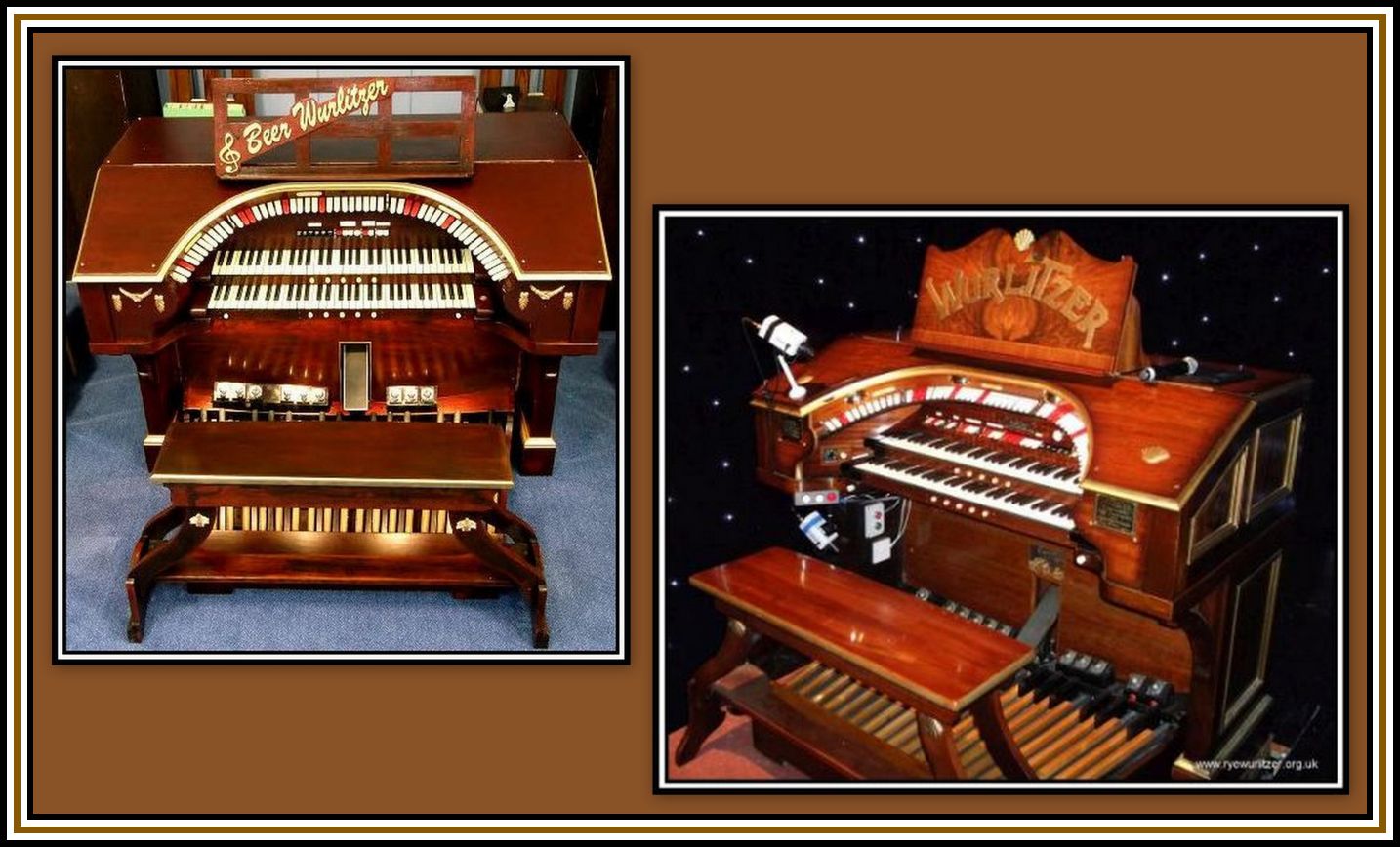 The Consoles of the Beer (Left) & Rye (Right) Wurlitzer Organs
The Consoles of the Beer (Left) & Rye (Right) Wurlitzer Organs
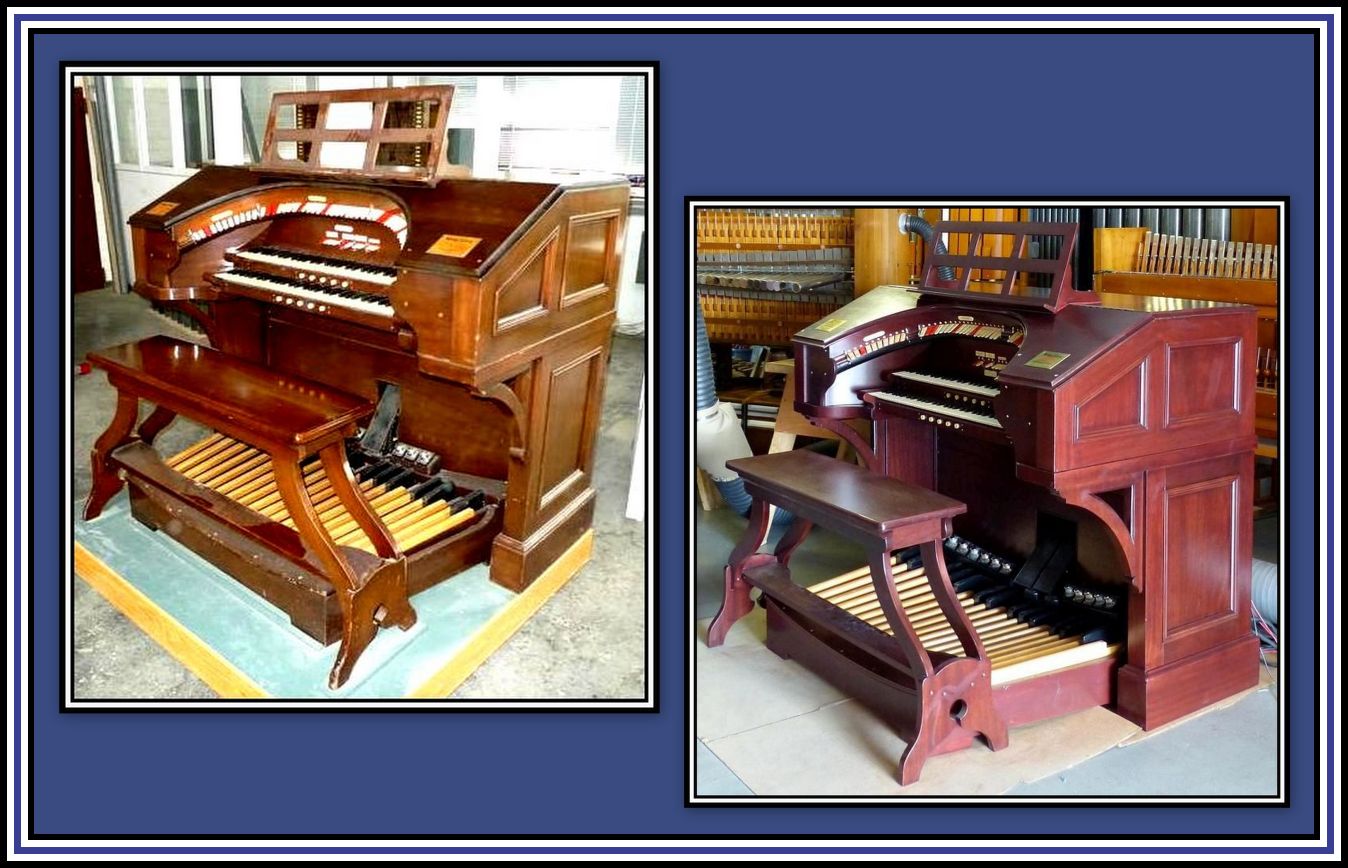 Additional Examples of Consoles of Style-D Wurlitzer Organs
Additional Examples of Consoles of Style-D Wurlitzer Organs
-oOo-
The Style-Da Organ omitted the Diaphone (16-foot Diapason) from the original specification, thereby reducing shipping costs and import duty.
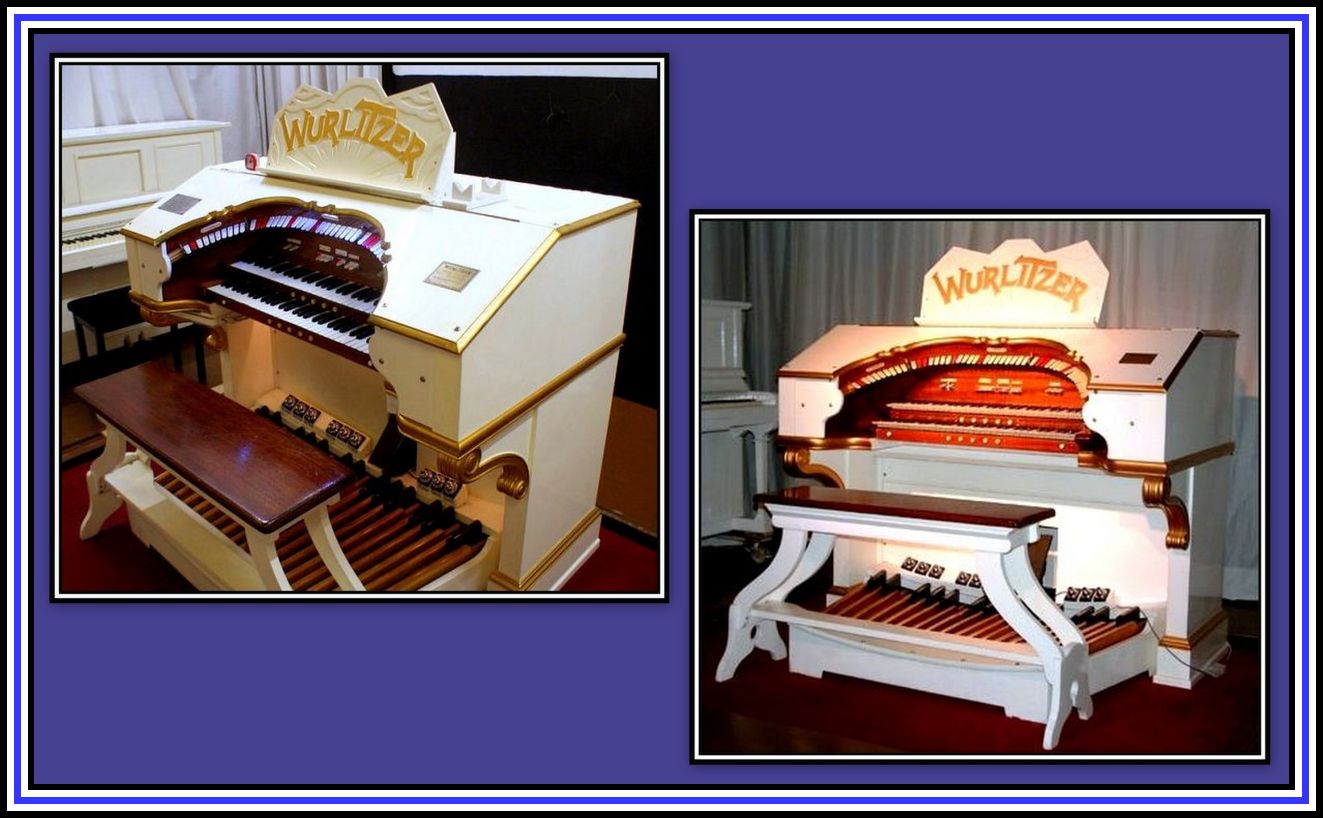 Example of a Console of a Style-Da Wurlitzer Organ
Example of a Console of a Style-Da Wurlitzer Organ
Only one Style-Da Wurlitzer Organ was sold in the U.K. and was installed at the Trocadero Cinema Liverpool. The organ is now at the Peel Green Heritage Centre (these photographs appear here with permission of Mr. David Allfred of The Lancastrian Theatre Organ Society).
-oOo-
The Style-E Wurlitzer Organ was similar to the Style-D, differing only by the addition of an extra rank of pipes.
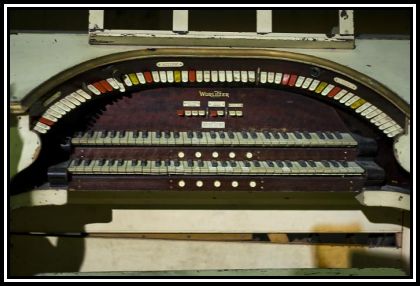 Console of the Style-E Wurlitzer Organ
Console of the Style-E Wurlitzer Organ
-oOo-
In standard form, none were sold in the U.K., however there was one Style-E “Special” Wurlitzer Organ, which was brought to the U.K. from the Almira Theatre Cleveland, Ohio and installed at the Rex Cinema Stratford in East London. This Organ was purchased in 2010 and has been restored and is now installed at the Royalty Cinema Bowness-on-Windermere.
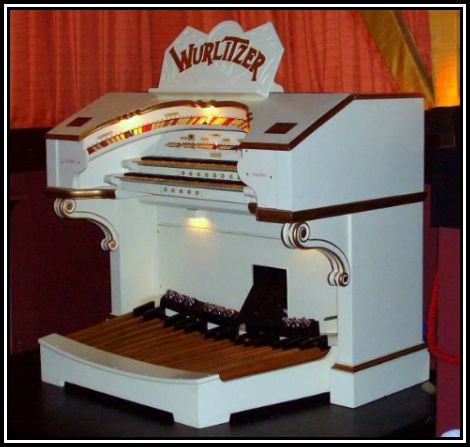 Console of the Style-E “Special” Wurlitzer Organ
Console of the Style-E “Special” Wurlitzer Organ
-oOo-
I recently received a comment regarding the Style-E Organ (to read it in full, please go to the Comment Section following this piece at the bottom of the page), which has prompted Mr. Paul Bland to offer additional information and which may be found with that of the Style-175 Organ below.
-oOo-
The Style-F Wurlitzer Organ was an eight rank instrument and, as with the Style-E Wurlitzer Organ, had some further additions to the percussion section. Of the standard (stock) models offered for sale in the U.K., the Style-F Organ proved to be the most popular in terms of sales. Fourteen such organs were sold and installed in British cinemas together with an additional three Style-F “Special” Organs.
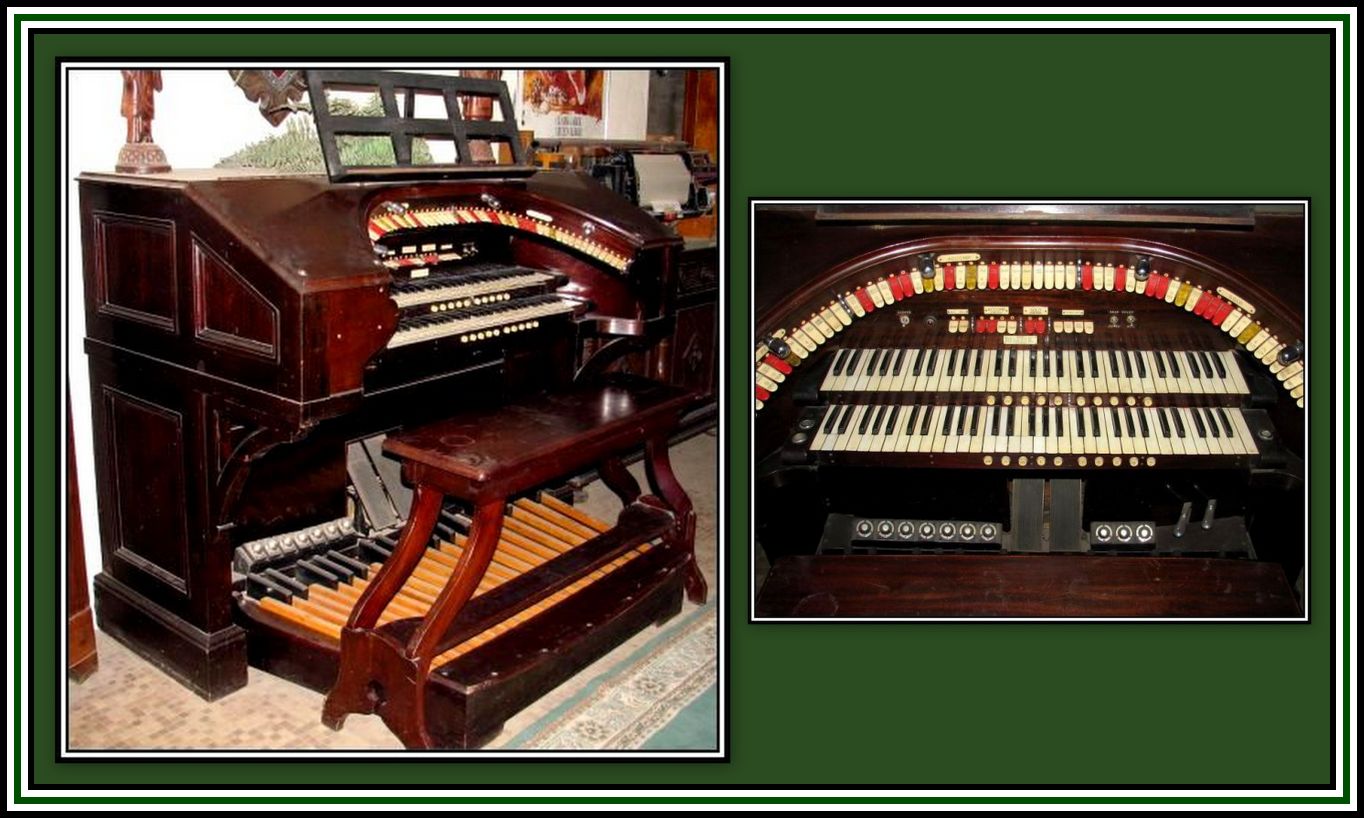 Console of a Style-F Wurlitzer Organ
Console of a Style-F Wurlitzer Organ
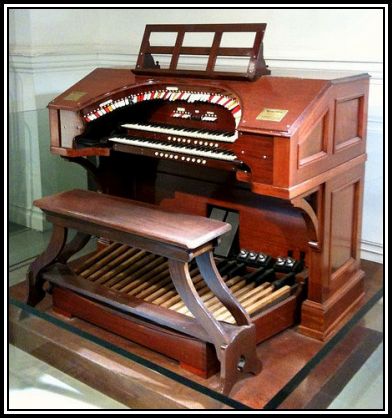 The Console of the New Gallery Cinema Wurlitzer Theatre Organ – Style-F
The Console of the New Gallery Cinema Wurlitzer Theatre Organ – Style-F
-oOo-
The largest 2-manual Wurlitzer Organ was the Style-H, which had ten ranks of pipes and was offered for sale in the U.S. together with a piano. However, in the U.K., Walter Pearce decided to sell it without the addition of a piano. It is possible that this decision was made in the hope of further reducing shipping costs. Only one of these organs was sold in the U.K. and it was installed at the Leicester Square Theatre.
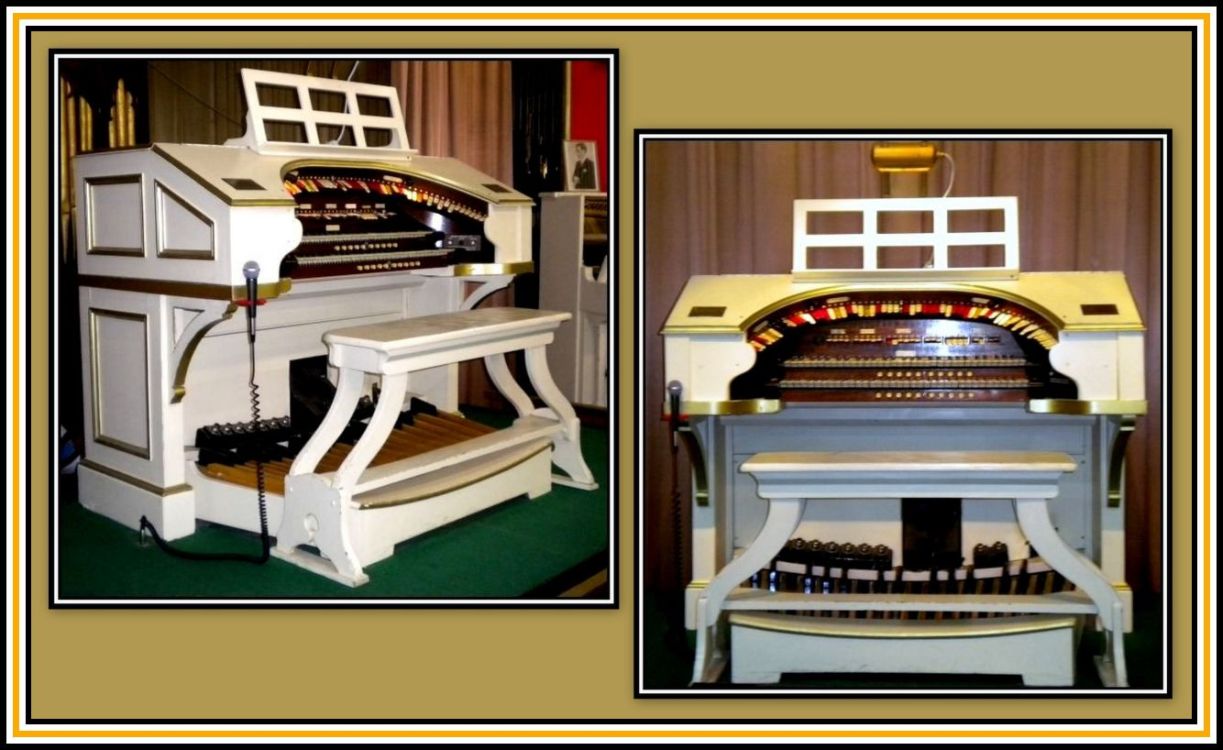 The Cotton Wurlitzer Organ Console – Style-H – these photographs appear here by permission of David Ivory
The Cotton Wurlitzer Organ Console – Style-H – these photographs appear here by permission of David Ivory
The Wurlitzer Organ of the Leicester Square Theatre is now housed at The Cotton Mechanical Music Museum near Stowmarket in Suffolk. The organ was originally installed at the Stillwell Theater in Brooklyn, but was repossessed and sent to London where it was installed at the theatre in Leicester Square once owned by Jack Buchanan and his associate. The theatre was eventually renamed the Leicester Square Theatre and the organ remained here until 1968 when the cinema was refurbished and it was removed.
 The Leicester Square Theatre Wurlitzer Organ
The Leicester Square Theatre Wurlitzer Organ
Once the organ arrived at Cotton, restoration was undertaken, which lasted from 1975 until it was opened to the public in 1982. The organ was originally constructed without a piano, but one has since been added by the Museum.
Click here to hear the Cotton Mechanical Music Museum Wurlitzer Organ
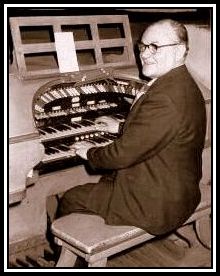 Gerald Shaw at the Leicester Square Theatre Wurlitzer Organ
Gerald Shaw at the Leicester Square Theatre Wurlitzer Organ
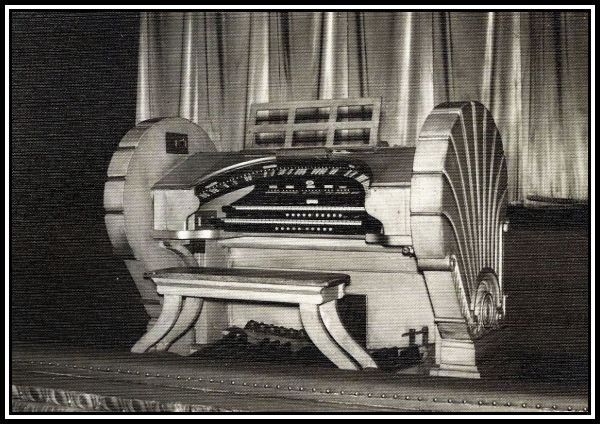 This photograph of the Leicester Square Theatre Wurlitzer Organ appears here with permission of Mr. David Ivory
This photograph of the Leicester Square Theatre Wurlitzer Organ appears here with permission of Mr. David Ivory
-oOo-
The three manual Wurlitzer Organs sold in the U.K. were Styles 235, 260 and 285. Seemingly, only one Style-260 was sold and this organ was installed at the Plaza Theatre in Lower Regent Street in London. The organ was a fifteen rank instrument with seven tonal percussion instruments.
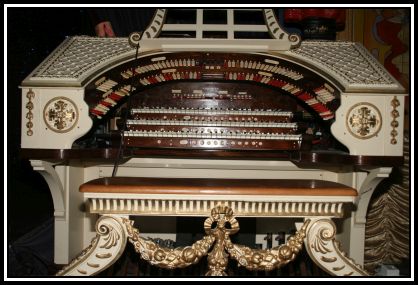 The Console of the erstwhile Plaza Cinema Wurlitzer Organ, Style-260, now installed at the Dreamfactory
The Console of the erstwhile Plaza Cinema Wurlitzer Organ, Style-260, now installed at the Dreamfactory
Click here to see and hear the Wurlitzer Organ, Style-260, installed at the Organ Stop Pizza
-oOo-
In 1928, The Wurlitzer Organ Company re-aligned and re-designated a number of their model names. All previous models that were designated by letters were given numbers. From an inspection of the 1929 Price List, it would appear that the higher the number, the bigger the instrument. Also from this price list, one is able to see the newer models on offer at this time.
 The Price List published in 1929
The Price List published in 1929
-oOo-
The Style-150 Organ was a replacement for the Style-B with four ranks of pipes. In its standard format, three such organs were sold in the U.K. together with an additional six Style-150 “Special” Organs.
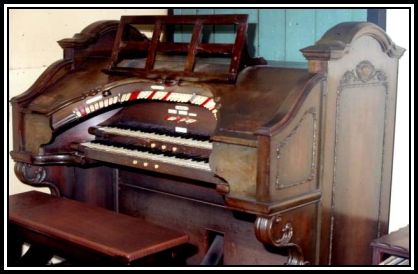 Console of a Style-150 “Special” Wurlitzer Organ
Console of a Style-150 “Special” Wurlitzer Organ
-oOo-
The Style-165 Organ was the successor to the 6-rank Style-D Organ. Five of these organs were sold in its standard format together with three “Specials”.
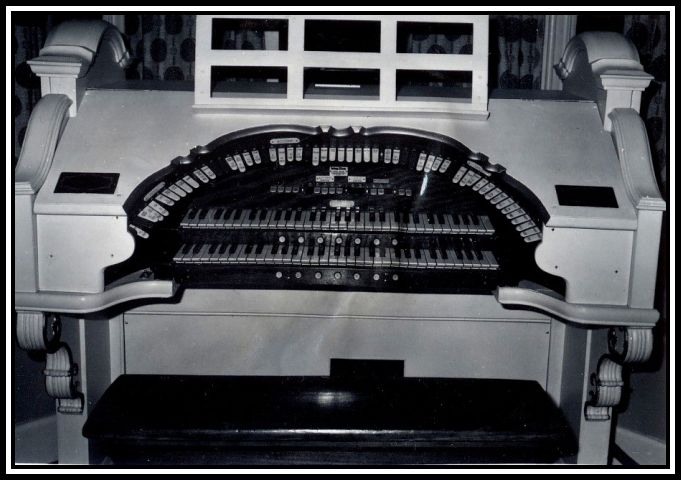 Console of the Style-165 “Special” Wurlitzer Organ of the Lido Cinema Hove
Console of the Style-165 “Special” Wurlitzer Organ of the Lido Cinema Hove
-oOo-
Recently I received a comment regarding Style-175 and Style E Organs, which may be read in full in the Comment Section at the bottom of this page, which prompted Mr. Paul Bland to offer some information regarding these Organs.
-oOo-
The Style-175 Organ was a replacement for the 7-rank Style-E Organ. Only one Style-175 and one Style-E Organs were sent to the U.K. and were installed at the Savoy Theatre Enfield and Rex Cinema Stratford respectively.
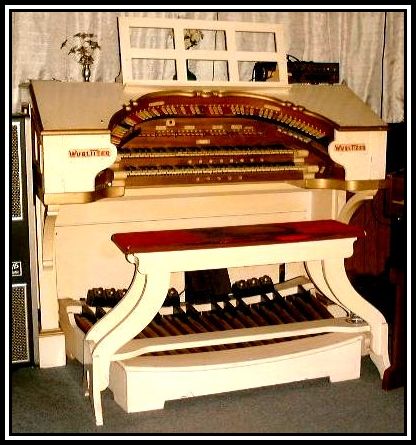 Console of a Style-175 “Special” Wurlitzer Organ
Console of a Style-175 “Special” Wurlitzer Organ
Mr. Paul Bland wrote to say that the Style-175 Organ, Opus 1319, had been shipped to a store in Buffalo, N.Y. in April 1926, as a Style D-2m/6r. It would seem that the instrument must have been re-possessed by The Wulitzer Company, as it was later shipped to England in August 1936 and installed at the Savoy Theatre Enfield with the following additional ranks: Trumpet, Diapason, Tibia Clausa, Salicional, Flute and Vox Humana.
The Style-E Organ, Opus 1719, was manufactured at a later date, and was shipped to the Almira Theatre Cleveland, Ohio in August 1927. Some time later, it was returned to The Wurlitzer Factory and then shipped to England in September 1934 still as a Style-E Organ and installed at the Rex Cinema Stratford.
Both Style-175 and Style-E Organs have identical specification, 2m/7r plus 4 tuned percussions and traps.
Mr. Bland says that I was correct in saying that the Organ installed at the Rex Cinema Stratford was the only Style-E Special shipped to the U.K., but he also notes that the term “Special” is somewhat vague, as it could have been applied to any one of a number of slight variations on the basic model.
Mr. Bland also says that the model installed at the Savoy Theatre Enfield was identical to that installed at the Rex Cinema Stratford, but, in catalogue terms, it arrived in the U.K. as a Style-175 (and not a Style-E), and also notes that enthusiasts need to remember that this Organ had originally been built as a Style-D Organ.
Mr. Bland states that any confusion regard the Style of these two Organs is the result of the anomaly caused by The Wurlitzer Company’s revision of its Model Numbers.
Mr. Bland notes that much of his information comes from The Wurlitzer Opus List compiled by Mr. Judd Walton (1970; updated in 1973).
-oOo-
The eight rank Style-F Organ was replaced by the Style-200 Organ and in its standard format only one instrument was sold in the U.K. However a number of “Specials” based on this instrument were purchased by the Gaumount Cinema Circuit during the late 1920’s and early 1930’s for installation in their new Picture Palaces. These Palaces included the Regent Cinemas built at Brighton, Bournemouth and Hanley and the New Victoria at Preston, as well as a few other cinemas. A total of eight Style-200 “Special” Organs were installed in the U.K. each with nine ranks of pipes.
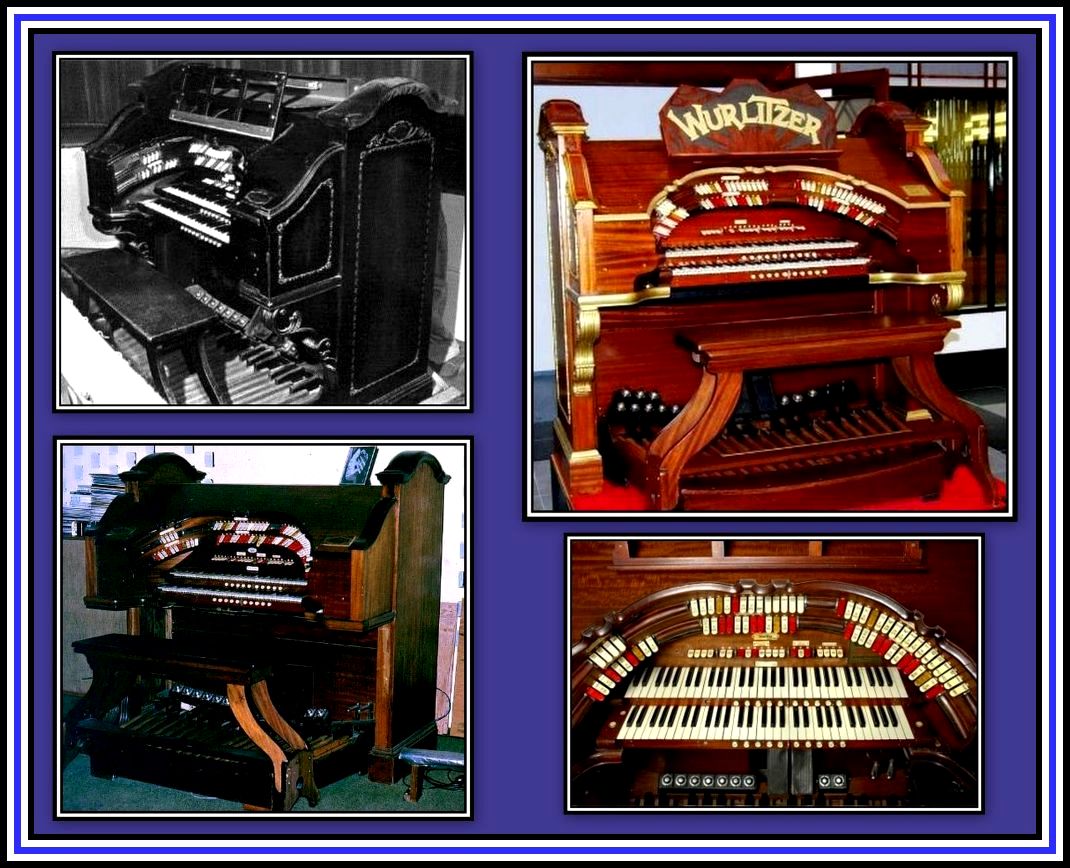 Consoles of Style-200 Special Wurlitzer Organs
Consoles of Style-200 Special Wurlitzer Organs
-oOo-
The Style-205 Organ was a new model introduced and was the largest of the two manual instruments. In standard format, none were sold in the U.K. However the first organ installed in the Blackpool Tower Ballroom and the organ at the Metropole Cinema Victoria in London were Style-205 “Specials”.
-oOo-
From the revised list of 3-manual organs offered by Walter Pearce, the only model that sold in the U.K. was the Style-220, as a “Special” with five such 220-Specials being purchased for installation at the New Victoria Bradford, the Troxy Stepney, the Dominion Walthamstow and the Granada cinemas at Edmonton and Kingston.
 Bobby Pagen (Left) & the Console of the Style-220 “Special’ Wurlitzer Organ of the Troxy Stepney
Bobby Pagen (Left) & the Console of the Style-220 “Special’ Wurlitzer Organ of the Troxy Stepney
Click here to hear Bobby Pagen play the Theatre Organ
-oOo-
Between 1924, when the first Wurlitzer Theatre Organ was sold in the U.K., until the last sale in 1939, a total of one hundred instruments were installed. Approximately one third of the organs sold were standard (i.e. stock) models while the remainder was for “Specials” including those designed exclusively for particular cinema chains.
——-ooOOOoo——-
Click here to go to
PAGE THREE of PART TWO:
DECORATION of THE WURLITZER THEATRE ORGAN CONSOLE
——-oooOOOooo——-
ACKNOWLEDGEMENTS
I would like to thank Mr. David Ivory and Mr. David Allfred of The Lancastrian Theatre Organ Society for his kindness and to all those that helped to produce this page.
I am very grateful to Mr. Brian Greaves and Mr. Paul Bland for their comments and information to this page.
——-oooOOOooo——-
——oooOOOooo——
Click here to return to PAGE ONE of PART TWO: THE WURLITZER ORGAN
——oooOOOooo——
Click here to return to PART ONE: INTRODUCTION
——oooOOOooo——
Click here to return to the THEATRE ORGANS HOME PAGE
——oooOOOooo——
Click here to return to the GLOSSARY
——oooOOOooo——
Click here to return to the TABLE OF CONTENTS
——oooOOOooo——

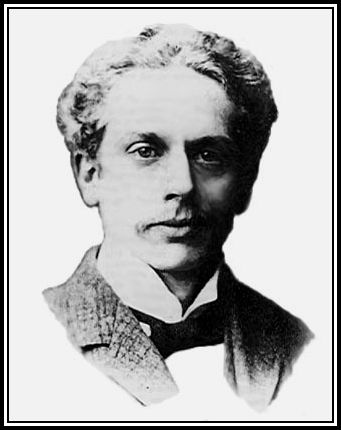
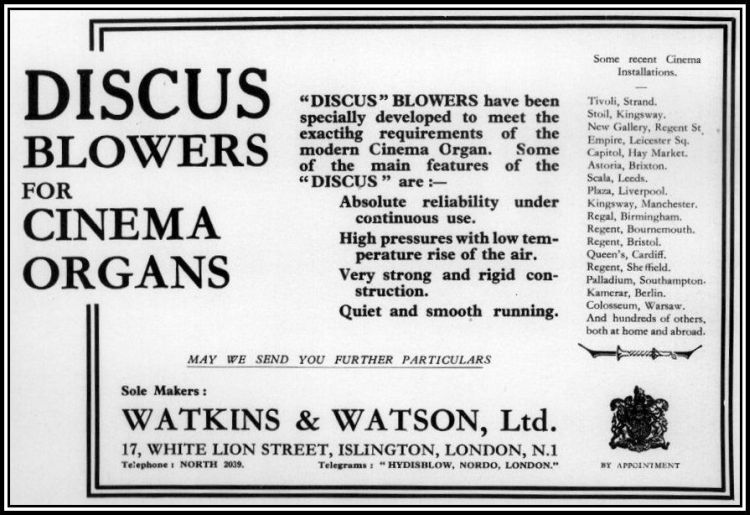
Regarding the Ex Rex Stratford being the only style E “Special” in the UK, I’m afraid that is not quite correct. It had an identical twin(in every respect) that was installed originally in the Ex Savoy Enfield. One of its ‘homes’ was in the Ex Silver Jubilee Club in West Hallam, Derbyshire where I was lucky enough to help maintain it now and then. I believe it is now in store in the Spalding area.
Mr. Greaves: Many thanks for your interesting comment regarding the E ‘Specials’ in the U.K. I appreciate you taking the time to write. Regards. CSPJ
Hello and Happy New Year,
I’m an ex-organ builder living in northern Italy and would like to like to purchase a small (4-6 rank) Compton or Wurlitzer to install in a local theatre here. Please drop me a line if you know of anything available – I imagine you’re much more up to date with the UK organ scene than myself!
Many thanks in advance,
Andrew Jolliffe
0039 3888 637 072
I have sent you a reply to your email address. Charles